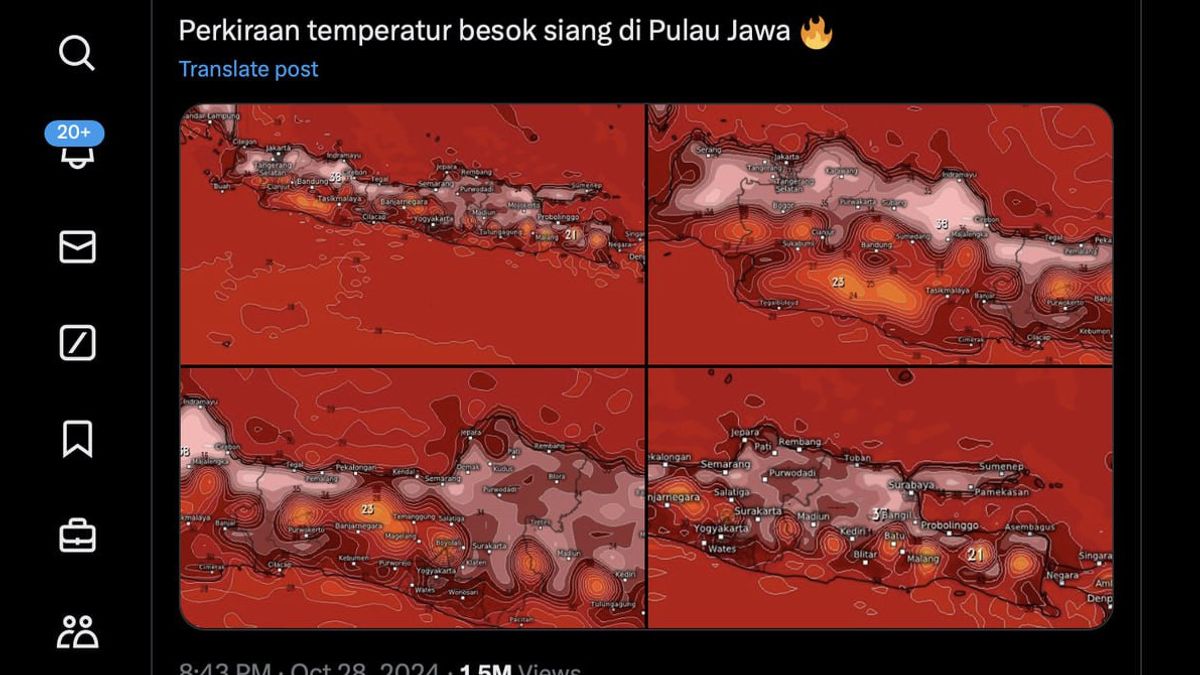YOGYAKARTA - Uploads that show the red image of the Java Island satellite at the end of October 2024 have become the talk of many people. So what is the cause?
The upload began on the X (Twitter) account @zaki said on Monday (28/10/2024).
"The estimated temperature tomorrow afternoon on the island of Java," wrote the uploader.
Meanwhile, several netizens in the comments column of the upload also complained about the hot air temperature, even at night.
The Head of the Weather Prediction and Early Warning Team of the Meteorology, Climatology and Geophysics Agency (BMKG) Ida Pramuwardani explained that the red color seen in the Java Island satellite image marks a high surface temperature.
"Satellite images that show red color on the island of Java usually indicate a high surface temperature or a low soil humidity area. This condition can occur due to several factors," he said as reported by VOI.
He explained that although October is usually a marker of the start of the rainy season, this year there is a possibility of rain delays in several areas.
This condition was triggered by global weather which resulted in dry atmospheric conditions. Thus, this keeps the surface temperature high.
In addition, the presence of tropical cyclones near Indonesian territory, such as Cyclone Kong-rey which has recently been active, can attract moisture from the surrounding area, including Java Island.
"As a result, the humidity in the area is reduced and the surface temperature increases, which can be seen as a red color on satellite imagery," explained Ida.
Meanwhile, another factor that affects satellite imagery on the island of Java reddening is due to the phenomenon of extreme summer season.
Ida explained, in recent years, BMKG data concluded that there was a shift in the pattern of the season which made October still feel hot, especially in the tropics.
This can be due to atmospheric conditions that change from year to year.
"Therefore, although October is usually the beginning of the rainy season, several factors such as atmospheric conditions and the influence of tropical cyclones could delay or reduce the intensity of rain," explained Ida.
"So, this causes surface temperatures to remain high and appear as red areas on satellite imagery," he added.
The Head of the BMKG Public Meteorology Center, Andri Ramdhani, explained that over the next few days the hot temperature condition is expected to remain in the Java to East Nusa Tenggara (NTT) region.
The Kong-rey Tropical Cyclone which is currently active in the Pacific Ocean also affects weather patterns in the region by attracting humidity from the surrounding area, including Java to NTT, thus inviting dry air conditions and increasing temperature.
Andri explained that the cyclone is expected to weaken in the next few days as it moves away.
However, its effect on humidity and temperature in Indonesia can still survive until atmospheric conditions return to normal. Therefore, during this period, explained Andri, it is important for people in the Java to NTT regions to be aware of the potential impact of high temperatures, and always follow information and warnings from the BMKG.
In addition, his party also appealed to the public to always maintain health by reducing outdoor activities during the day, ensuring that the body remains hydrated, and periodically monitor air temperature.
SEE ALSO:
"At the same time, the public also needs to be aware of the potential for extreme weather during this season's transition period which is short and uneven, such as moderate to heavy rain, hail, and strong winds, as well as local-scale phenomena such as tornadoes. Usually this potential occurs in the afternoon until evening," he concluded.
That's a review of the cause of the red image of the Java Island satellite. Visit VOI.id to get other interesting information.
The English, Chinese, Japanese, Arabic, and French versions are automatically generated by the AI. So there may still be inaccuracies in translating, please always see Indonesian as our main language. (system supported by DigitalSiber.id)
















